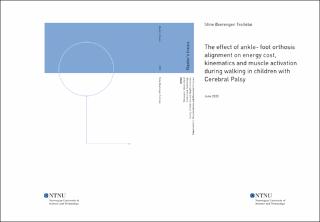| dc.contributor.advisor | Ihlen, Espen Alexander | |
| dc.contributor.advisor | Roeleveld, Karin | |
| dc.contributor.author | Trollebø, Stine | |
| dc.date.accessioned | 2021-09-25T16:27:17Z | |
| dc.date.available | 2021-09-25T16:27:17Z | |
| dc.date.issued | 2020 | |
| dc.identifier | no.ntnu:inspera:56454695:8663459 | |
| dc.identifier.uri | https://hdl.handle.net/11250/2783077 | |
| dc.description.abstract | Bakgrunn: Barn med cerebral parese (CP) opplever en økt energikostnad i forbindelse med deres reduserte gangevne. Denne økte energikostnaden er forbundet med kinematiske avvik og avvik i muskelaktiveringsmønster. En effektiv og økonomisk gange er derfor et viktig behandlingsmål hos barn med CP, og en ankel- fot ortose (AFO) er et vanlig brukt ortopedisk verktøy for å stimulere til dette. Justering av vinkelen på leggen i forhold til det vertikale, ved bruk av en fem millimeter hælkile, har vist en essensiell påvirkning på patologiske avvik som forekommer blant barn med CP.
Formål: Å undersøke effekten av ankel-fot ortoser, samt ankel-fot ortose justering med en 5 mm hælkile på energikostnaden under gange. Sekundærformål for studien er å kartlegge mulige endringer i spatiotemporale gangparameter, kinematikk og muskelaktivitet.
Metode: Syv barn med CP (gjennomsnittsalder 10.86 ± 3.14) utførte tre gangtester for å estimere deres energikostnad under gange. I tillegg utførte de en 3D ganganalyse for å vurdere kinematikk og muskelaktivitet under gange. Begge testprosedyrer ble utført ved bruk av tre ulike kondisjoner, bestående av 1) Gange med sko, 2) Gange med deres nøytrale AFO innstilling (AFOn), og 3) med den justerte AFO innstillingen (AFOa). Justeringen ble implementert ved å bruke en 5 mm hælkile som ble plassert mellom fotbladet og skosålen.
Resultat: Energikostnad ble redusert når man sammenlignet gange med AFOn med sko (5.55 j/kg/m og 5.91 j/kg/m). Det ble funnet en signifikant forskjell i tid i singel support og dobbel support fasen, hvor AFOa hadde en kortere tid i singel support (SS), og en lengre tid i dobbel support (DS) sammenlignet med sko (p=0.04 and p=0.03). Lengden i singel support fasen var signifikant kortere for den affiserte foten enn den friske foten for alle tre kondisjonene (p=0.00). Kinematiske data for hofteleddet viste en signifikant større hofteekstensjon i SS for den affiserte foten ved gange med sko sammenlignet med AFOa (p=0.04). I svingfasen (SW) ble det funnet en signifikant reduksjon i hoftefleksjon ved gange med AFOn og AFOa sammenlignet med sko for den affiserte foten (p= 0.00 og p=0.01). Den friske foten viste en signifikant redusert hoftefleksjon i SW når man sammenlignet AFOa med sko (p=0.04). For ankelleddet demonstrerte AFOa en signifikant høyere dorsalfleksjon ved første hælistett for den affiserte foten, sammenlignet med AFOn (p=0.04). I svingfasen viste også AFOn og AFOa en signifikant høyere dorsalfleksjon sammenlignet med sko (p=0.00).
Konklusjon: Gange med den nøytralt justerte AFOen viste en signifikant redusert energikostnad sammenlignet med sko. Videre viste begge AFO kondisjonene signifikante endringer i kinematikken i ankel- og hofteleddet sammenlignet med sko. | |
| dc.description.abstract | Background: Children with cerebral palsy (CP) experience an increased energy cost in relation to their impaired walking ability. This increased energy cost is connected to kinematic deviations, as well as deviations in the muscle activation pattern. Energy preserving walking is therefore an important treatment goal, and an ankle-foot orthosis (AFO) is a commonly used orthotic device to enhance this. Adjusting the shank- to vertical angle (SVA) with a five- millimeter heel wedge has further demonstrated a crucial impact on pathological deviations that arises among children with CP.
Aim: To investigate the effect of ankle- foot orthosis and ankle-foot orthosis alignment with a 5 mm heel wedge on energy cost during walking in children with CP. Secondary aims are to examine possible changes in spatiotemporal gait parameters, kinematics, and muscle activity.
Methods: Seven children with CP ( mean age 10.86 ± 3.14) performed three walking tests to estimate their energy cost during walking. Additionally, they conducted a 3D gait analysis to assess kinematics and muscle activity during walking. Both test procedures were performed in three different conditions, consisting of 1) Walking with shoes, 2) Walking with their neutral aligned AFO (AFOn), and 3) Walking with an adjusted AFO (AFOa). The aligned adjustment was implemented using a 5 mm wedge placed between the footplate and the sole of the shoe.
Results: Energy cost was reduced when walking with AFOn compared to shoes (5.55 j/kg/m and 5.91 j/kg/m, respectively). AFOa demonstrated a significantly reduced time in single support, and a significantly longer time in double support compared to shoes (p=0.04 and p=0.03). Time in single support was significantly shorter for the affected leg in all three conditions (p=0.00). Kinematic data of the hip joint revealed a significantly increased hip extension in single support (SS) for the affected leg when walking with shoes compared to AFOa (p=0.04). In the swing phase (SW), there was a significant reduction in hip flexion when walking with AFOa and AFOn compared to shoes for the affected leg (p=0.01 and p=0.00). Similar for the unaffected leg, a significantly reduced hip flexion in SW was apparent when comparing AFOa to shoes (p=0.04). For the ankle joint, AFOa demonstrated significantly increased dorsiflexion (p=0.04) at initial contact (IC) compared to AFOn. Significant findings were also found in SW for the affected leg when comparing shoes to AFOn and AFOa (p=0.00 and p=0.00, respectively).
Conclusion: The use of the neutral aligned AFO significantly reduced energy cost during walking as compared to walking with shoes. Further, both AFO conditions revealed significant changes compared to walking with shoes in the kinematics of the ankle and hip joint. | |
| dc.language | | |
| dc.publisher | NTNU | |
| dc.title | The effect of ankle- foot orthosis alignment on energy cost, kinematics and muscle activation during walking in children with Cerebral Palsy | |
| dc.type | Master thesis | |
